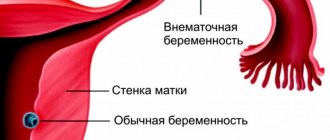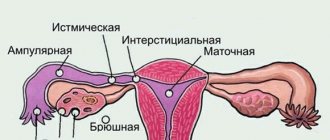The first subtle manifestations
Pain at the beginning and end of menstruation is most often perceived by women as normal.
But this is a possible sign of endometriosis, and a doctor can confirm this diagnosis.
The disease cannot be accurately diagnosed by visual and special examination. You need to do an ultrasound or take tests.
The alarm bell should be the pain that accompanies intimate contact or urination.
A dangerous symptom is uterine bleeding not associated with menstruation . Blood loss can make itself felt by pale skin and anemia.
In most cases, the reason to go to the doctor is that conception has not occurred for a long time . The specialist can prescribe an ultrasound, and then, if the diagnosis of endometriosis is confirmed, determine treatment tactics.
https://youtu.be/ZCMk4nOeLzY
Clots in menstrual flow
The appearance of menstruation with pieces of the endometrium directly indicates the development of endometriosis. This symptom can be considered one of the most obvious signs of the disease.
Note! In the first days of menstruation (especially if it is not accompanied by pain), the appearance of small clots is normal.
Scanty discharge, consisting of almost nothing but pieces of lining, as well as heavy, prolonged periods should alert you. But without a cytological examination it is impossible to figure out what the clot is.
For example, jelly-like formations in no way indicate endometriosis. Most likely, natural anticoagulants simply did not have time to completely dissolve the uterine lining before it came out. But dense pieces of tissue during menstruation can be a clear sign of endometriosis.
Symptoms as they develop
With the disease, symptoms are often vague or may be completely absent . This is determined by the degree of tissue proliferation, concomitant diseases and a number of other factors.
As the disease progresses, pain during intimate contact may intensify, menstruation may become heavier and longer, discomfort during urination and bowel movements may occur, and unsuccessful attempts to become pregnant for a long time .
If the endometrium is already growing strongly, it can be implanted into neighboring organs. This can lead to increased urination and constipation.
Bloody clots between periods should also make you wary.
Read about the causes of pain in the anus in women in this material.
Why does the lower left abdomen hurt in women? Find the answer to the question here in the publication.
What is endometriosis
Endometriosis is a disease that is characterized by the growth of the mucous layer of the uterus beyond its boundaries. During menstruation, pathological foci spread to other organs and begin to multiply. The endometrium grows, the sexual organ increases in size and its structure becomes denser. If pregnancy does not occur during ovulation, the endometrium dies wherever it ends up. A feeling of compression will form in places that are not intended for this, and because of this, pain will appear. The disease can cause infertility. If a woman does not treat the pathology, the situation will not stabilize.
Endometriosis can be divided into 2 forms:
- genital – the reproductive system is affected;
- extragenital - penetration of endometrial cells into neighboring organs.
Endometriosis may be a complication after cesarean section
The disease may appear due to the following reasons:
- heredity;
- excess amount of estrogen, little progesterone;
- conceiving a child at a late age;
- complications during childbirth;
- surgical termination of pregnancy. The disease especially appears when a woman has a late abortion;
- cauterization of cervical erosion;
- caesarean section during childbirth;
- performing a biopsy of the genital organ;
- operations in gynecology;
- damage to the genital organ. When the uterus is injured, a fresh wound is formed, into which cells penetrate and further grow where they should not.
Smoking, drinking alcohol, and eating an unhealthy diet increases the risk of developing endometriosis.
After a woman reaches 45 years of age, endometriosis can occur due to the onset of menopause.
How does the disease manifest itself?
It is worth taking a closer look at the specific manifestations that can make themselves felt in this disease.
What kind of pain: nature and localization
All types of pain that occur with endometriosis are characterized by cyclicity: they depend on the menstrual cycle.
Much depends on the location of the pathology. How and what does it hurt with endometriosis? Does your lower abdomen hurt?
When the body of the uterus is damaged, intense pain occurs . They are cramping and occur at the beginning of menstruation.
Such sensations can be constant, sometimes weaken, sometimes intensify.
If the lesions are located in the cervix, the pain is more moderate and usually manifests itself during intimate contact.
When the retrocervical space is affected, the pain can be very severe, since the endometrium can penetrate the rectum and vagina, and there are many nerve endings there.
Then the lumbosacral region will hurt, especially during menstruation.
If the ovaries are affected, painful attacks will occur during menstruation. They may be accompanied by severe nausea and vomiting.
Endometriosis of the intestines and bladder is also possible , then the pain will manifest itself in the pelvic area, intensifying with defecation and urination.
Discharge, whether there is bleeding, its intensity
The discharge is bloody. They become inflammatory (mucous or purulent) if an infection is added to the disease.
They will be cyclical - appear before, during or after menstruation, but their abundance and density will be determined by localization.
If there is growth in the body of the uterus, menstruation will be heavy, with noticeable bloody clots. The discharge may continue for another 3-5 days after menstruation, and may appear before it begins.
If the disease appears in the cervix and vagina, spotting may also appear before menstruation. In the second half of the cycle, especially during sexual intercourse, they are brown.
If the intestines or bladder are affected, bloody discharge is observed during bowel movements or urination.
Menstruation: how periods go, what they are like
Endometrial growth affects the menstrual cycle. Menstruation may become longer, painful, and heavy. However, with ovarian dysfunction, on the contrary, they can become scanty.
The menstrual cycle may be disrupted , and excruciating pain is possible.
They are also able to pass acyclically or contactally (just smear). All this indicates violations.
People often ask: why does it hurt in the right lower abdomen in women? Read about this in this detailed article.
How to relieve toothache with home remedies? Details are in this publication.
You can learn about the treatment of bladder inflammation in women from this material.
Indirect symptoms
Indirect signs include discomfort in the pelvis and lower back, which may occur periodically.
Sometimes general weakness, drowsiness, fatigue, and irritability are observed, although they can indicate many other diseases not related to the reproductive system.
The pain symptom may subside or disappear completely after the end of menstruation. This is due to the cyclical development of mucous membrane tissues.
Menstruation after endometrial cleansing
Many women decide to undergo surgery to clean out excess endometrium, hoping that normal menstruation will be restored. Immediately after curettage, bloody discharge, including clots, may be observed.
But the next menstruation should be completely painless. However, you need to prepare for the fact that endometriosis with all the accompanying symptoms will return in a few months.
Overgrowth of the uterine lining can be called a “chronic” condition. However, do not despair: the right therapy will allow you to live a normal life. A healthy pregnancy is also highly likely to solve the problem of endometriosis.
Transition from acute to chronic form
The danger of endometriosis is that if it does not manifest itself in any way and is not treated, then there is a risk of it becoming chronic .
Chronic endometriosis goes away calmly. In rare cases, bleeding before menstruation and pain, which are characteristic of the disease, are possible.
However, the absence of symptoms does not mean the disease is safe. Slow and steady growth of the endometrium provokes functional infertility.
Endometrial cells are practically inactive, but the body reacts to them by enveloping them in plugs, adhesions, and forming cysts.
Most often, chronic illness provokes discomfort, which appears or greatly intensifies before menstruation. During a long-term, difficult process, such sensations are constant.
During menstruation, dark discharge in clots is possible , and after it - spotting. This usually indicates intrauterine endometriosis.
Surgery
Overgrown uterine lining tissue can be removed surgically. This procedure is called “endometrial curettage.” As a rule, it is chosen by women who do not want to take synthetic hormonal drugs, because in the future it may affect their reproductive ability. Thanks to the operation, the basic function of the organs is preserved.
Surgical intervention will be aimed at removing foci of the disease. The main disadvantage is that after the procedure, foci of abnormal endometrial proliferation do not disappear, and after some time the outer lining of the uterus grows again.
In addition to conventional abdominal surgery, laparoscopic surgery is increasingly being used in modern gynecological clinics. Before this, laparoscopy is performed - a diagnostic operation that is done through several millimeter incisions in the abdominal cavity. It is highly effective and minimally invasive.
Laparoscopic surgery allows for more targeted removal of the affected areas, which lengthens the period of relapse. In addition, due to the nature of the procedure, the recovery time is greatly reduced (up to three days).
When and which doctor should you go to?
Since the disease sometimes does not manifest itself at all or makes itself felt with symptoms that we perceive as normal, it is important to undergo regular examinations to prevent it.
If you notice pain, cycle disorders, discharge, pain during sexual intercourse, urination, defecation, go to the gynecologist . He will prescribe the necessary tests and then adequate treatment tactics.
Several groups of medications are used to treat endometriosis. Sometimes surgery is required.
More about the signs and treatment of endometriosis:
Now you know everything about the first signs and symptoms of endometriosis of the uterus, ovaries and other organs in women.
By noticing the warning symptoms of endometriosis in time (pain in the lower abdomen, discharge, unusual periods) and curing the disease, you will prevent its serious complications, and one of the most unpleasant ones is infertility.
Menstruation with endometriosis is usually heavy and prolonged due to the rejection of the endometrium from the uterine cavity and further growth, beyond its limits, to other neighboring organs, fallopian tubes, ovaries, kidneys, intestines, and cervix. Less often, but the periods are poor, scanty, with clots.
To restore the cycle
Restoring the cycle after treatment for endometriosis is a very difficult task. The fact is that endometriosis is a chronic and relapsing disease; medicine has not yet found the optimal treatment. Surgery and hormonal therapy can provide a temporary effect, but it is unlikely that the problem will be completely solved.
Some achieve a more or less stable cycle by constantly taking hormonal contraceptives, or installing the Mirena intrauterine device; some stop suffering after successful conception, birth and breastfeeding of a child. After all, pregnancy, childbirth, and breastfeeding definitely change the cycle and contribute to the treatment of endometriosis.
Surgical removal of the lesions usually brings relief, but after 5 years the disease may return in 50% of cases.
Medications used:
- Progestogens – the most commonly used are Visanne (dienogest) or the Mirena intrauterine device. When taking Visanne, breakthrough bleeding and spotting are possible, but after two months of a continuous course, menstruation stops and resumes only after 4-8 weeks. As a rule, the drug helps stabilize menstruation. The IUD should not cause a complete cessation of menstruation, but under its influence they pass painlessly, with scanty discharge and at stable intervals.
- Antigonadotropins (danazol, nemestran) are rarely used nowadays due to the high level of adverse reactions. The course of treatment is 6 months, after two months menstruation stops completely. After a course of therapy over the next month, the cycle is restored, critical days become less painful.
- Gonadotropin-releasing hormone (GnRH) agonists – zoladex, buserelin and others. Under their influence, the patient experiences all the delights of menopause; 4-8 weeks after stopping the course, menstruation resumes, but pain on average decreases by 4 times. It is important to understand that these drugs have a huge number of side effects.
- Ulipristal acetate (Esmya) has a centralized effect on the endometrium; under its influence, in the second month of use, menstruation no longer comes, and the cycle is restored 4 weeks after stopping use. Helps stabilize the menstrual cycle and reduce blood loss.
Read more The first menstrual cycle in girls
Menstruation with endometriosis is usually heavy and prolonged due to the rejection of the endometrium from the uterine cavity and further growth, spreading beyond its limits to other neighboring organs, fallopian tubes, ovaries, kidneys, intestines, cervix. Less often, but the periods are poor, scanty, with clots.
Foci form when endometrial tissue accumulates in one place, penetrating deep into the organ that has become a target as a result of endometrial growth. With the onset of menstruation, endometrial tissue is shed and a new layer grows in place. With growth, a disease develops - endometriosis, the change in menstruation in nature is painful. The disease requires treatment based on ultrasound, prescribed to women if suspected.
Why does endometriosis develop?
There is no exact reason for the development of the disease. The hereditary factor plays a major role; endometriosis also develops against the background of a failure of hormonal immune processes. Women at risk include:
- after 30 years;
- having undergone abortion, cesarean section, diathermocoagulation of the cervix or erosion.
Doctor intervention before the start of the menstrual cycle is especially dangerous. Endometrial cells can penetrate into the wounds, their growth will go into the thickness of the cervix, then into the pelvic cavity.
Causes of endometriosis
Endometriosis ranks third among the most common gynecological diseases after various inflammations and uterine fibroids. Today, all the causes of this disease are still not clear. Some scientists claim that hereditary factors and poor ecology are to blame, while others suspect a violation of the hormonal balance and the woman’s immune system.
In some patients, endometrial particles enter other organs and directly into the blood during menstrual flow, and then they attach to the tissues and continue to function unhindered. If fertilization does not occur, the endometrium is rejected, as in the uterine cavity, while creating pressure in the place where it is attached, causing pain and discomfort.
There is a group of factors that increase the risk of developing a pathological process:
- heredity;
- decrease in the hormone progesterone and increase in the amount of estrogen;
- first pregnancy after 30 years;
- difficult birth with various complications;
- artificial termination of pregnancy;
- C-section;
- cervical biopsy, cauterization of erosion and other methods.
During treatment of the cervix immediately before the onset of menstruation, cells sometimes enter the fresh wound and subsequently grow. Bad habits and poor nutrition also affect your overall health and increase the risk of developing a pathological process.
How do periods change with endometriosis?
As the endometrium grows, a woman’s periods become more and more painful, painful, abundant and prolonged, or, conversely, scanty (with ovarian dysfunction, insufficient production of hormones). The accumulation of secretions in the uterus leads to its increase in size and compaction of the structure. With the development of endometriosis, for example, blood particles leave the cervix when it is palpated. Unfavorable conditions for ovulation are created. It simply does not happen, which indicates that it is impossible until the problem is fixed.
With the development of endometriosis, a woman’s hormonal levels are disrupted. The endometrium stops developing in the uterus, the egg does not mature inside the ovaries, resulting in delayed periods and their irregular arrival. The fallopian tubes are susceptible to focal manifestations of endometriosis. The disease negatively affects the reproductive functions of women and, first of all, the menstrual cycle is disrupted. Excruciating pain appears before the onset of menstruation.
Of course, endometriosis occurs differently in women, but in any case it must be treated. The pain usually begins shortly before menstruation, the discharge on menstrual days goes away:
- abundantly and for a long time;
- scantly, no more than 3 days;
- acyclic;
- contact (simply smear).
Basically, with endometriosis, menstruation is heavy, prolonged and painful, which indicates dysmenorrhea.
- Dysmenorrhea occurs with:
feeling of heaviness in the lower abdomen 3 days before menstruation;
- the appearance of increasing pain. The closer the critical days are, the more;
- pain radiating before the onset of menstruation up the abdomen, in the lower back;
- pain on the first menstrual day, reaching its peak;
- sensations of pain that disappear 2-3 days after the start of bleeding.
Symptoms directly depend on the stage of endometriosis. As it progresses, it hurts almost constantly. The cycle is not broken, but pain during menstruation and throughout the entire period is debilitating, exhausting, the feeling of pain is constantly present. The syndrome is stable if adenomyosis additionally begins to develop. At grade 4, surgical intervention is no longer possible.
- Menorrhagia occurs when endometriosis is pronounced. There is endometrial hyperplasia and uterine leukomyoma. For menorrhagia:
- pain begins at the beginning of menstruation, discharge is scanty;
- if the pain syndrome subsides, the woman begins to experience blood loss.
- discharge is copious, with clots;
- the symptoms of menstruation are pronounced within 3 days, on the 4th day the discharge becomes less intense, on the 5th day there is no heavy discharge, but it can smear for a long time;
- Menstruation lasts up to 8 days.
Blood loss is dangerous for the body; excessive blood loss is fraught with anemia, decreased performance, rapid fatigue, weakness, and drowsiness.
Oligomenorrhea is manifested by shortened periods lasting no more than 3 days. This condition is associated with hormonal disorders in ovarian endometriosis, a sharp decrease in the functioning of the endocrine system. For scanty periods:
- smears, pain appears only at the beginning of menstruation;
- for 3 days the discharge is insignificant, the duration in general is no more than 3 days.
- Acyclicity, irregular menstruation. Also possible with endometriosis. When interviewing a doctor, a woman cannot indicate the exact date of her menstruation. The discharge is acyclic, that is, it can be different: scanty, short, copious, long-lasting, painful. They may be absent altogether, arrive with a delay, causing women a lot of inconvenience, irritation, nervousness and physical discomfort.
- Bleeding and discharge are insignificant, smearing, and may appear throughout the entire menstrual cycle. They often occur after sexual intercourse, when lifting weights, as a result of the introduction of vaginal suppositories, douching, and even during palpation by a doctor during the examination. Menses are smeared when diagnosing endometriosis of the uterus, vagina, vulva, ovaries, isthmus.
- Hypomenorrhea, scanty periods with blood loss of no more than 50 ml. Headaches appear, also in the lumbar region, sternum, lower abdomen, nausea, and intestinal dysfunction. Possible nosebleeds. The secretion of estrogens decreases, along with them libido and reproductive functions. Scanty periods occur when:
- endometrial inferiority;
- after abortions, frequent curettages;
- against the background of inflammatory tuberculosis.
If the secretion of produced hormones is disrupted, the circulatory system in the uterus ceases to circulate normally. The endometrium is incomplete during menstruation, resulting in scanty discharge. The triggering of the mechanism for the development of hypomenorrhea is possible due to:
exhaustion of the body, loss of body weight;
- hypovitaminosis, anemia, metabolic disorders;
- stress, overload, nervous disorders;
- performing surgery on the genitourinary tract;
- partial removal of the uterus;
- underdevelopment of the female genital organs;
- endocrine diseases;
- infectious diseases (in particular tuberculosis) of the genital organs;
- harmful radiation exposure, chemical poisoning;
- severe intoxication of the body.
Discharge during hypomenorrhea comes out in dark or light brown spots, accompanied by nausea, headaches, lower back pain, constipation, and dyspeptic disorders. Spasmodic contractions of the uterus and sharp pain during menstruation may not occur. Scanty periods are not pathological when menstrual function fades or restores. But in the reproductive phase, this is a serious disorder for women and a reason to consult a doctor.
It is important to establish the cause of menstruation irregularities. If the hormonal regulation of endometriosis is disturbed, menstruation can be scanty and prolonged, with complications, infertility develops, and in the absence of menstruation for a long time, amenorrhea occurs. When the endometrium is inflamed, the discharge is brown and scanty, there is an unpleasant odor, and the lower abdomen hurts. Such discharge often occurs after intrauterine intervention due to post-abortion endometritis or infectious diseases. Dark bloody, brown discharge may not be painful, but this is also a sign of endometriosis.
Lack of menstruation with endometriosis
Delayed menstruation with endometriosis is an atypical symptom of this disease. A slight delay is within normal limits, but not more than three or four days. The absence of menstruation for more than a week is a good reason to visit your doctor. Consultation and examination are necessary if the interval between monthly bleedings has significantly lengthened.
Another delay can be caused by factors not related to the pathology of the uterine mucosa:
- Experienced stress.
- Physical overexertion.
- Taking oral contraceptives.
- Conception.
- Climate change.
- Approaching menopause.
There is no special treatment for this situation. Therapy will be selected based on the underlying cause of the cycle disorder. In most cases, it is enough to improve your lifestyle and diet.
Pregnancy
Many patients with endometriosis experience infertility. But sometimes the disease develops during pregnancy. Unfavorable conditions are created for the development of the child in the womb, therefore the risk of miscarriage increases.
There is a risk for the woman herself. The appearance of uterine perforation can cause sudden rupture of the organ, followed by severe bleeding. Therefore, gynecologists recommend undergoing a full examination before conceiving. If the patient has already been diagnosed, then it is extremely important to give birth to a child only after complete recovery.
Hormonal imbalance
When the pregnancy test is negative, it is necessary to look for other reasons for the delay. Doctors explain in the following way whether menstruation may not occur due to endometriosis.
Pathological growth of the endometrium negatively affects the functioning of the ovaries. The egg needs more time to mature due to hormonal imbalance. An incorrect balance of hormones inhibits the development and process of subsequent tissue rejection.
As a result, the woman notices first minor delays, and then a complete absence of menstruation. Lack of progesterone provokes bleeding at any time of the cycle of unknown origin.
Cervical lesions
When the cells of the uterine cavity grow in the cervical area, bloody discharge cannot come out. This form of the disease is less common than others, but it is the one that develops into malignant neoplasms without treatment. The larger the area of endometriosis, the higher the risk of adhesions.
The absence of menstrual flow in one cycle is a serious reason to visit a gynecologist. With timely diagnosis, treatment will only include medications, when in advanced forms it is rarely possible to do without surgical intervention.
Eliminating Latency
To find out exactly how to induce menstruation with endometriosis, it is necessary to establish the cause of the failure. For minor violations, sedatives, a balanced diet and proper rest will help. You can use traditional medicine, but after consulting a doctor. After all, herbs give only a one-time result without eliminating the problem with the cycle.
The basis of treatment for delay is preparations with progesterone. The course is prescribed on an individual basis after confirmation of a lack of progestins in the body. They drink Duphaston for endometriosis from the 16th to 25th day of the cycle, but it is also possible to use Utrozhestan. Most often, the length of the cycle does not change, and menstruation begins on schedule.
Heavy periods with blood clots
Observed with enlarged endometrium, its rejection with damage to blood vessels. When blood clots, menstruation occurs profusely, with pieces of endometrium or clots. They appear with endometrial hyperplasia against the background of the release of large amounts of estrogens. Normally, only lochia after childbirth is considered. The discharge is profuse with clots and lasts from 3 to 6 weeks. Over time they become lighter. If you experience prolonged periods with an unpleasant odor, similar discharge after childbirth, or pain or fever, you should visit your doctor.
If uterine bleeding is heavy, how to stop it?
With endometriosis, many women experience heavy periods. The condition leads to anemia and the bleeding must be stopped urgently.
The doctor will prescribe dicynon, vikasol, tranexam, diferelin. To contract the uterus - contrical, oxytocin, ergometrine. Ascorutin and folic acid will help strengthen the walls of blood vessels. In the treatment of endometriosis, regardless of the stage, danazol, Zoladex, Novinet, and Duphaston are prescribed. With prolonged bleeding and low hemoglobin levels based on test results, surgical intervention is possible.
In case of severe bleeding, douching and taking warm baths are prohibited. It is also not recommended to take medications to stop bleeding without a doctor’s prescription to avoid complications.
Laparoscopy is an advanced technique in the treatment of endometriosis. It involves inserting tubes (three) through punctures into the peritoneal cavity. Tubes filled with gas act on pathological lesions, destroying them. As a result of resection, endometrial lesions are removed without damaging the organ. However, this method cannot take endometrial samples for biopsy; relapses are also possible; restoration of endometrial tissue after its destruction is not always successful.
Medicinal herbs together with medications help stop bleeding. Only with the permission of a doctor, plantain juice helps to relieve inflammation and stop bleeding. The shepherd's purse has the same effect. Brew and drink before meals 2-3 times a day.
Conservative methods of eliminating bleeding in patients with endometriosis
The doctor draws a conclusion on how to stop uterine bleeding based on the results of a survey of the patient, examination in a gynecological chair and other necessary procedures. Conservative treatment of bleeding in endometriosis is based on long-term use of hormonal and symptomatic medications. The goal of such therapy is to normalize the functioning of the ovaries, eliminate bleeding and new foci of the disease.
In case of heavy blood loss over a long period of time, the patient is prescribed hemostatic drugs. Among such hemostatic agents, experts highlight Diferelin, Vikasol, Dicion, etc. Medicines such as Secomethrin, Oxytocin, Panergal stop blood and reduce its loss during menstruation. To strengthen the walls of capillaries and reduce the fragility of veins, Ascorutin, Profilaktin S, etc. are prescribed.
The conservative method of eliminating blood loss in endometriosis is based on hormonal therapy.
The main means of hormonal therapy are:
- combined estrogen-gestagen drugs;
- progestogens and gestagens;
- antiprogestins;
- GnRH agonists.
When treating endometriosis accompanied by blood loss, the attending physician prescribes estrogen-gestagen combination drugs, for example Zhanine and Diane-35. The actions of the drugs are aimed at normalizing the menstrual cycle and stopping heavy bleeding. The duration of treatment is individual. In the fight against heavy blood loss due to endometriosis, oral contraceptives are the most effective and safest means of hormonal therapy for a woman’s health.
Progestogens (Duphaston, Ingesta Oxy, Visanne) are characterized by a progestogenic effect, a decrease in estrogen levels, a reduction in the proliferation of endometrial cells and a decrease in the intensity of blood loss.
With the help of antiprogestins (Danazol) heavy blood loss is stopped. These drugs have a number of side effects, which explains the significant decrease in prescriptions and sales of such drugs.
Agonist drugs (Buserelin, Zoladex) are widespread and very effective in combating bleeding in endometriosis. These drugs are available in two forms: injection and spray. In most women, after using agonists, blood loss stops within 1.5-3 months.
How do periods change after treatment for endometriosis?
Menstruation begins to go according to schedule, but failures are possible if:
- stress, anxiety before the upcoming operation;
- taking hormonal medications;
- increased physical activity (there may be a delay).
The cycle may change after surgery if large affected areas had to be removed. The day of the operation is the beginning of a new cycle. If your period is not on time, it is considered late. It can be up to 5 days, maybe up to 2-3 months when taking hormonal drugs prescribed after surgery to restore the background. There may be scanty discharge and ichor as a result of wound healing, but they have nothing to do with menstruation.
Deviations are considered to be abundant brown discharge, clots, maybe bright red with an unpleasant odor. This is a reason to see a doctor again and undergo a full examination. Disorders of the menstrual cycle and hormonal levels inevitably lead to infertility. There is simply no favorable environment left for the embryo to form in the uterus. Even if pregnancy occurs, maintaining it against the background of developing endometriosis is extremely difficult. Cyclicity is disrupted, ovulation is absent, and infertility occurs. It is menstruation that occurs normally that indicates the hormonal and physical well-being of women.
Blood loss or, conversely, scanty discharge is a reason to visit a gynecologist and undergo an examination. Pain and excessive bleeding are the main signs of endometriosis. In the absence of treatment for the disease, the changes become more pronounced, leading to breakdowns, neurotic disorders, and the woman fails to become pregnant. The disease is insidious, and at the first suspicion, completing the full course of treatment is extremely important for the woman’s future health.
One of the gynecological diseases that can send the most patient woman to the doctor is endometriosis. They suffer from it mainly during reproductive age. Therefore, menstruation with endometriosis, or more precisely, the changes that occur with them, is one of the reasons to suspect the disease.
Read in this article
How to normalize a cycle
In order to restore the cycle, a specialist may prescribe medications that contain gestagen and progesterone. Hormones provide artificial menstruation and control its regular occurrence. To reduce pain, non-steroidal anti-inflammatory drugs can be used, for example, Nise, Nimesulide, Nimesil, Nurofen, Ibuprofen, Mig and others.
If a woman has severe endometriosis, treatment is carried out only surgically (laparoscopy). During the operation, all pathological areas are removed. After the intervention, there may be a delay in menstruation, but the cycle returns to normal after 2-3 months.
Recovery depends on the psychological state of the female body and her hormonal levels.
In very rare cases, it is possible to combine surgery with medication. To do this, the gynecologist writes a prescription for contraceptives to regulate the menstrual cycle. If new foci of endometriosis do not appear, menstruation returns to normal.
You can increase progesterone levels by following nutritional recommendations and physical activity. It is also necessary to reduce the number of stressful situations and increase your immunity.
Endometriosis has a negative impact on the general condition of the body. Without treatment, the disease will not go away on its own, so it is necessary to promptly contact a gynecologist if your menstrual cycle changes. The specialist, in turn, will conduct an examination and prescribe the necessary procedures and treatment.
Endometriosis is a gynecological disease in which pathological growth of the endometrium occurs into the cavity of other organs, in addition to the uterus. A change in the menstrual cycle often precedes the disease; menstruation is also delayed with endometriosis, pain in the lower abdomen and other symptoms occur depending on the location of benign growths. The disease can lead to infertility, so treatment should not be delayed.
Briefly about the disease
The endometrium is the upper layer of the inner cavity of the uterus, part of which is regularly separated and excreted, replaced by a new one. Under the influence of various factors, whose nature is not fully understood, this tissue begins to grow outside the organ. During examination, it is seen mainly within the genitourinary system, and sometimes in different parts of the intestine. Naturally, menstruation with endometriosis of the uterus contains not only the cells of its inner lining, but also those neoplasms that are localized in other organs.
Hormonal disorders are both one of the causes and a consequence of the disease. Therefore, menstruation with such a diagnosis is also characterized by irregularity. Sometimes this makes you wonder whether there are periods with endometriosis in principle, since the disease affects the main organ involved in the process. Menstruation not only comes, but it is easy to confuse it with uterine bleeding. However, cycle failure and long delays with endometriosis are also not excluded.
Delay
Endometriosis most often affects young girls and women before menopause. The symptoms of this disease and its effect on the menstrual cycle largely depend on the age of the patient and the characteristics of the pathology. Endometriosis can be genital and extragenital. In the first case, only the genital organs are affected, and in the second, adjacent ones as well.
Delayed menstruation with endometriosis can have several main reasons, namely:
- Pregnancy. Patients with endometriosis are often diagnosed with infertility. However, in rare cases, the disease can occur during pregnancy. This pathology is especially dangerous, as it can lead to miscarriage. If you are planning to conceive a child, be sure to undergo a full examination first and make sure that you do not have endometriosis.
- Damage to the inner layers of the uterine walls. With abnormal growth of endometrial cells, the functioning of the ovaries is disrupted. Because of this, menstruation is delayed. If the duration of the cycle constantly increases, you should immediately contact a gynecologist. If there is a lack of female hormones, menstruation may stop altogether.
- Damage to endometriosis of the cervix. Growths of endometrial tissue prevent the passage of menstrual flow. The patient may experience a prolonged delay in menstruation, and then begin to bleed heavily and painfully. This form of endometriosis is very dangerous, as it can become malignant. As the pathology progresses, adhesions form in the cervical canal, which limits the movement of sperm and leads to infertility.
- Hormone imbalances. Due to excessive production of the hormone estrogen and insufficient production of progesterone, the egg develops more slowly. In this case, the endometrium matures on time, but bleeding does not begin. This disruption of the natural process is accompanied by pain and discomfort.
Regardless of the reason, a delay in menstruation is a reason to make an appointment with a gynecologist. The doctor must conduct an examination and, if necessary, prescribe additional diagnostics. This may be ultrasound, bacteriological culture, hysteroscopy or laparoscopy. If pathological foci of the endometrium are detected, the physician must take the biomaterial for additional laboratory testing. Correct and timely treatment of endometriosis will normalize the cycle and get rid of dangerous consequences.
The effect of endometriosis on the regularity of menstruation
The disease is characterized not only by an excessive number and abnormal distribution of endometrial cells. With it, the tissues of the uterus can become denser, and the organ itself can increase in size. The growth of the mucous membrane of the internal cavity of the uterus leads to the fact that the ovaries cannot function normally. When the reproductive cell matures longer than usual, then with endometriosis there may be a delay in menstruation, which is repeated more than once. Another cause is the germination of tissue in the cervical area, which prevents discharge. The hormonal imbalance inherent to the disease, which prevents the endometrium from developing, contributes its share to the process. And it takes more time to reach the state in which it is rejected, hence the delay.
An even more common feature of the cycle, which is caused by endometriosis, is menstruation 2 times a month. Moreover, this does not mean the maturation of the egg in both cases. It’s just that estrogens prevail over progesterone at all stages of the cycle, which does not happen normally.
Endometriosis during menstruation disrupts the normal balance, stimulating the secretion of organ cells. When the amount of estrogen decreases slightly, the upper layer of the mucous membrane begins to be rejected.
Heavy periods as a clear sign of endometriosis
The average volume of menstrual flow in a healthy woman is normally 50-70 ml. But with endometriosis, the amount of monthly blood released can exceed 80 ml. This is very dangerous, because there is a risk of developing anemia.
Some women lose much more blood. Extremely heavy bleeding is observed when the endometrium grows outside the uterus (into the fallopian tubes, ovaries, pelvic cavity).
Since the structure and hormonal nature of the uterine lining does not change depending on the location, blood begins to ooze not only from the uterus, but also from the affected organs.
How much menstrual flow occurs with endometriosis?
The question of what menstruation is like with endometriosis cannot be answered unequivocally. You can say that they are different, but this is too vague and not informative. The nature of menstruation is determined by the long-term effect of estrogen on the uterine mucosa, as well as the degree of growth of the endometrium and the places where its tissues are localized.
Heavy menstruation is one of the main signs
Women who are encountering these manifestations for the first time may ask whether menstruation is heavy with endometriosis. Most often this is what happens. The intense discharge that accompanies the disease is easy to explain. After all, the amount of tissue that is rejected during menstruation has increased due to the abnormal growth of the mucous membrane. The endometrium, which has grown outside the uterine cavity, is often localized in the fallopian tubes. This causes heavy bleeding between periods as well.
Heavy periods with endometriosis may be accompanied by spotting before and after the process. This happens when the outer part of the cervix and vagina are affected. This localization of the disease also causes contact bleeding, that is, after sex or a gynecological examination. The location of the endometrial tissue in the intestine causes spotting from the anus during menstrual periods. If a significant part of the organ is affected, problems also arise with stool.
In connection with all of the above, long periods with endometriosis are not uncommon. This is also due to uneven mucosal shedding caused by hormonal problems.
Menstruation may last longer than a week, even if the daily discharge cannot be called heavy.
Intense and prolonged menstruation, repeated every month, leads to iron deficiency anemia, as the woman loses too much blood. With endometriosis, the body is not able to compensate for such losses on its own, so she feels weak not only on critical days, but also at other times.
Is it possible to have scanty menstruation?
Endometriosis and scanty periods are a much less common combination than heavy bleeding. But this is also possible with this disease. It has already been said that when the ovaries are damaged, ovulation is difficult or completely impossible. Disturbances in the functioning of these organs with high estrogen levels provoke infertility. The amount of progesterone is reduced, the development of the endometrium is inhibited. The germination of its tissues in the vagina and cervix causes disruption of their secretory function. Therefore, discharge on critical days is scanty. But this does not guarantee the absence of bleeding at other times of the cycle.
Heavy menstruation
The intensity of discharge at the beginning of the cycle is explained by the pathologically large growth of the uterine mucosa, and therefore the amount of tissue rejected increases. Read about the normal thickness of the endometrium before menstruation. If foci of the disease are present in the fallopian tubes, then blood loss is observed both before and after menstruation.
With endometriosis, heavy periods are the main sign of the disorder. But this symptom is not observed in all women. Most often, dysmenorrhea occurs, which can be combined with scanty discharge and large blood loss with clots. Its main symptom is pain, which manifests itself in different ways:
- feeling of heaviness shortly before regulation;
- unpleasant sensations of an increasing nature;
- painful impact in the stomach and lower back;
- unbearable pain on the first day of menstruation.
Long periods with large daily blood loss increase the risk of iron deficiency anemia. The female body can no longer independently compensate for the lack of microelements. Therefore, there is a systematic feeling of weakness at any time.
Risk of uterine bleeding
Menorrhagia or hypermenorrhea is observed with pronounced endometriosis. Endometrial hyperplasia or leukomyoma is often present.
It must be remembered that if there is heavy bleeding, you should not douche or bathe in hot water.
You should be careful in case of a sudden loss of strength or increased drowsiness. It is imperative to go to the hospital if the pad gets wet within half an hour against the background of very pale skin.
Hemostatic drugs should not be taken without a doctor's prescription.
Menstrual pain with endometriosis
A characteristic symptom is pain during menstruation with endometriosis. Critical days, even in full health, rarely go without these sensations. But the disease sometimes makes them intolerable. Nagging pain occurs even before the critical days. It starts in the lower abdomen, extends to the lower back, and can be accompanied by brown smear. Sensations take over the pelvic area, subside and increase.
Endometriosis complements painful periods with other unpleasant symptoms:
- Nausea, possibly vomiting;
- Severe weakness;
- Difficulty urinating if the cells of the inner lining of the uterus have grown into these organs;
- Problems with stool.
The sensations can be constant, shooting, aching, gripping, but always very pronounced. What makes them so is the abnormal location and rejection of endometrial tissue with damage to blood vessels.
Causes of delay in endometriosis
Endometriosis is a “travelling” disease. This comparison is explained by the fact that endometrioid lesions can be found theoretically in any place and organ. Cases of endometriosis of the eye, brain, and liver have been described; lesions are often found on the intestines, bladder, and abdominal covering of internal organs. For each case, the reason for delay in endometriosis can be explained differently.
Uterus
Endometriotic damage to the structures of the uterine body is called adenomyosis. In this case, lesions are found in the endometrium, the muscular layer and can “drill” through the uterus, reaching the serous cover of the organ and affecting adjacent structures. For a number of reasons, adenomyosis is often associated with endometrial polyps of various natures and glandular hyperplasia. And all these conditions are associated with delayed periods.
How to stop menstrual bleeding
Heavy menstruation caused by endometriosis, of course, needs to be corrected. You can reduce them and shorten your critical days by using products based on medicinal plants:
- Nettles. It contains vitamin K, which promotes blood clotting, and C, which restores strength and helps absorb iron. 1 tbsp. Brew 200 ml of water, boil for 15 minutes, strain and drink a quarter glass several times a day;
- Yarrow. The plant helps make the walls of blood vessels stronger and also soothes pain. The remedy is prepared as from nettle and taken in the same way. The decoction can be drunk outside of critical days for prevention;
- Viburnum bark. 1 tbsp. crushed raw materials are poured with a glass of boiling water. After 10 minutes of infusion, you can drink 2 tsp. 3-4 times a day. The drug constricts blood vessels, increases muscle tone of the uterus, relieves pain characteristic of monthly manifestations of endometriosis;
- Shepherd's purse and peppermint. Herbs taken in a 2:1 ratio reduce the permeability of capillaries, preventing them from rupturing and releasing blood. For 2 tbsp. 200 ml of boiling water and infusion for half an hour is enough for the dry mixture. Take 1 tbsp. 4 times a day;
- Highlander. Take 3 tsp. raw materials per 200 ml of boiling water, combine, keep for an hour in a closed container. The infusion is taken 3 times a day, 1 tablespoon;
- Water pepper. 1 tbsp. The crushed plant is placed in 200 ml of boiling water and left for an hour. To strengthen the walls of blood vessels, reduce pain and blood clotting, drink 1 tbsp. 3 times a day;
- Horsetail. For infusion you need 2 tsp. raw materials and 200 ml of boiling water. The product is prepared in 2 hours; it has not only a hemostatic, but also a wound-healing effect.
Medicines for menstrual bleeding with endometriosis
Sometimes everything is much more serious, and a woman during menstruation risks simply bleeding if she loses more than 80 ml of fluid per day. In such cases, a specialist must decide how to stop menstruation with endometriosis. Hemostatic drugs used:
- Etamzilat 2 tablets 3 times a day. The gynecologist may prescribe a different dosage, based on specific circumstances. The drug promotes the formation of platelets, due to which the blood clots faster;
- Tranexam. The dosage is the same as the previous remedy, but it can be taken 4 times a day. The drug increases blood viscosity, which helps reduce the volume and duration of discharge;
- Dicynone. This is an analogue of Etamzilat, the number of tablets taken for prolonged periods caused by endometriosis is the same;
- Vikasol. It is more effective intramuscularly, as it acts faster in this form. The effect of taking the tablet will become noticeable only after 8 hours;
- Ascorutin. Its hemostatic effect is based on strengthening the vascular walls. The drug contains rutin, which makes them less permeable and fragile;
- Diferelin. Used from the first day of the cycle, its hemostatic properties are based on the effect on the ovaries in order to correct the production of hormones;
- Oxytocin. Constricts blood vessels and increases the tone of the uterine muscles. Injected intramuscularly 1-2 ml 2 times a day;
- Ergometrine. Strengthens the smooth muscles of the uterus. There are different forms of the drug for oral administration and injection. 0.2 g 3 times a day is enough.
Cycle recovery
Conservative treatment of endometriosis is carried out using drugs containing gestagens or progestins. These hormones artificially create menstruation by controlling its regularity. They prepare women's bodies for pregnancy. Additionally, non-steroidal anti-inflammatory drugs are used to relieve pain during menstruation.
Severe forms of endometriosis are treated surgically using laparoscopy. This removes all visible lesions. After surgery, cycle disturbances are possible. Within 2-3 months, menstruation becomes regular. The duration of recovery is related to the psychological state of the woman and the stabilization of hormonal levels.
In special cases, doctors combine surgery and drug support for the body. The gynecologist prescribes contraceptives to regulate the menstrual cycle. If new foci of endometriosis do not arise, then the delays pass.
You can increase progesterone levels with proper nutrition, moderate exercise and healthy sleep. Increasing immunity is the main goal of the recovery phase. The absence of stress has a positive effect on the female body.
How and when to operate for endometriosis
The disease at the initial stage with small foci of cell proliferation is treated conservatively using hormonal drugs. But in most cases, surgical methods followed by the use of the same medications are necessary to preserve reproductive capabilities. When the cells of the uterine mucosa are localized in its cervix and cavity, scraping or cleaning is used. The functional layer is removed with instruments and sent for examination. What remains is the sprout, which retains the ability to form external cells, that is, all functions of the organ are preserved.
Endometriosis must be cleaned during menstruation if it is an emergency operation due to heavy bleeding. It can also be done routinely on critical days, if a diagnosis was previously carried out, and the material has already been examined, and the diagnosis has been confirmed. This is a more physiological and gentle method, since the endometrium is already rejected. Curettage during menstruation minimally injures the organ and allows you to restore its functions in a short time. A planned operation can be carried out several days before, then the resulting material is sent for research. In addition, endometriosis before menstruation is especially clearly visible due to the cyclical nature of its development. This is important, because accidentally leaving minimal lesions will inevitably cause a relapse.
The spread of the disease to the ovaries, appendages, and other organs will require laparoscopic surgery and also removal or cauterization of tissue, followed by hormonal therapy.
Reasons and possible time of absence of menstruation
A delay in menstruation can last from several days to several months. This is explained by the fact that progesterone levels decrease and the egg does not leave the follicle. The endometrium is not rejected, but grows inside the uterus. The norm is a delay of menstruation of up to 7 days. With endometriosis, there may be a delay of several menstrual cycles.
Ovarian cysts are considered a companion to endometriosis. During retrograde menstruation, migration of endometrial cells occurs. They take root in the tissues of the ovaries and fallopian tubes. Growths (endometriotic cysts) form, which inhibit the maturation of the follicle. Every month they bleed and prevent the body from releasing the required amount of hormones. There is a decrease in ovarian reserve, and the ability to become pregnant decreases every year.
The growth of the endometrium into the deeper layers of the uterus, such as the myometrium, is called adenomyosis. At the same time, the amount of estrogens increases and the volume of endometrial cells increases. Not enough progesterone is released for menstruation to begin.
Ovulation of the egg does not occur or occurs with a delay.










